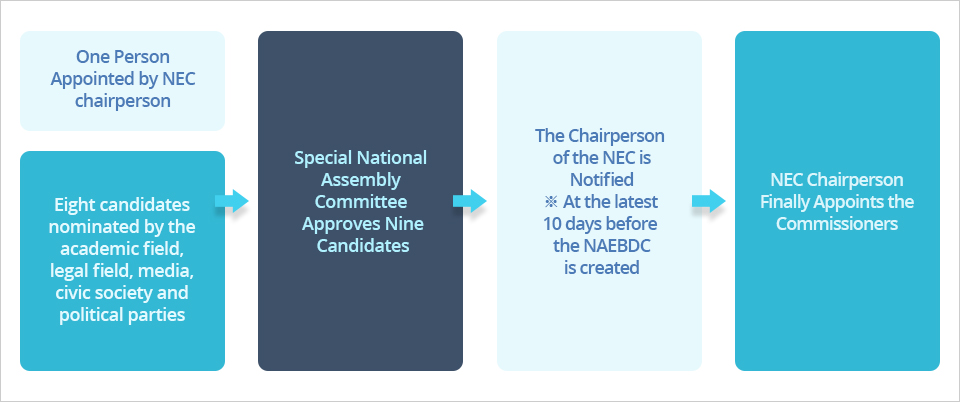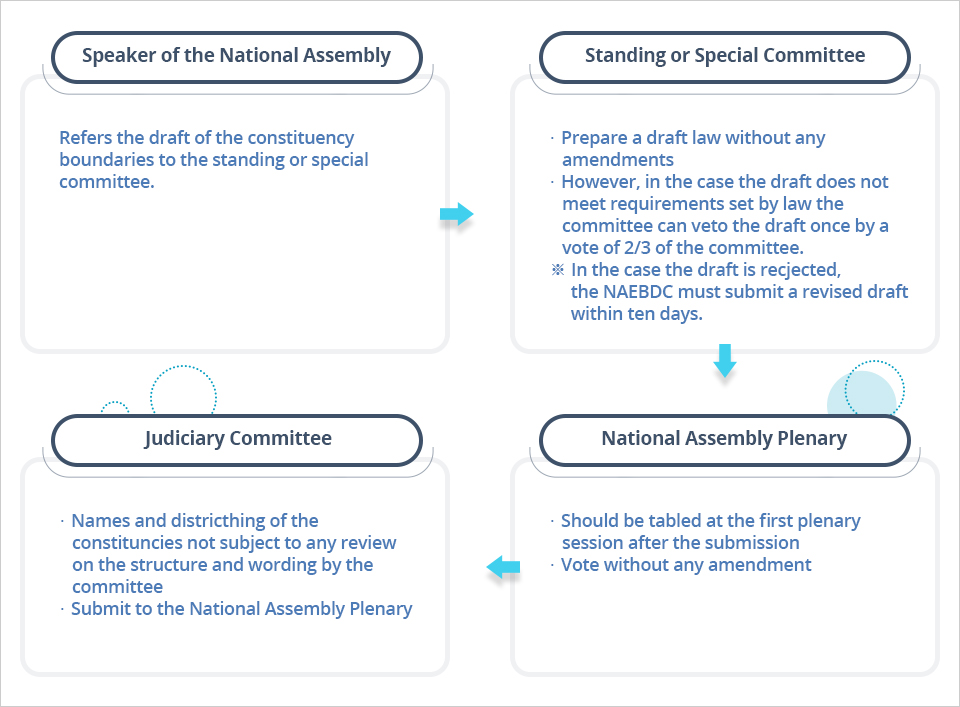About NEC
NAEBDC
HOME About NEC Organization NAEBDC
National Assembly Election Boundary Delimitation Commission
- Background
The National Assembly Election Boundary Delimitation Commission (NAEBDC) was first set up as an advisory body under the National Assembly for the 15th National Assembly elections, and at the time the draft of the National Assembly constituencies submitted by the NAEBDC only included declaratory provisions which urged the National Assembly to respect the draft when revising the law related to the name and area of electoral constituencies. Because of this the submitted electoral district plan was often unfairly arranged according to political interests, and the problem of the constituency boundaries not being delimitated early enough before election day happened frequently.
However, on 30 October 2014 the Constitutional Court decided that the difference between the largest and smallest district should be within a margin of 33.3% (A population difference of less than a ratio 2:1). According to this decision, it was necessary to adjust the constituencies drastically for the 20th National Assembly elections. This prompted strong calls for the improvement of the election boundary delimitation system.
Politicians began in earnest to improve the election boundary delimitation system as a symbol of the start of major political reform. As a result, the Public Official Election Act (Law 13334, amendment dated 2015.6.19) was amended to set up a new independent NAEBDC under the National Election Commission (NEC) for each National Assembly election and included measures to remove the power of the National Assembly to delimitate constituencies, including a provision that allows the National Assembly to veto the draft of the boundaries delimitated by the NAEBDC only once.
As an independent body under the Constitution, the NEC is guaranteed to be political neutral. In addition, as an election-management institution, it has a high level of expertise and was able to secure manpower to ensure the NAEBDC installation. Therefore the NEC was authorized to establish with no burden and with social trust and understanding.
The NAEBDC for the 20th National Assembly elections was launched as an independent commission under the NEC and outside the National Assembly, the direct stakeholder of boundary delimitation, on July 15, 2015. It ran until March 3, 2016 until the boundaries for the 20th National Assembly elections were finalized.
The NAEBDC was officially launched on December 7, 2018 to delimitate the boundaries for the 21st National Assembly. - Mission
The NAEBDC is assigned to delimitate election constituencies fairly in accordance with delimitation guidelines set under Article 25.1 of the Public Official Election Act. It should then submit the draft constituency boundaries and a report on the reasons why any changes were made and any other necessary details to the Speaker of the National Assembly by 13 months before National Assembly elections.
- Formation
- Period
The NAEBDC is set up from 18 months prior to National Assembly elections due to the end of the term of office until the constituencies have been delimitated and those constituencies have been confirmed and come into effect.
- Formation
Under the NEC, independent in carrying out all duties
- Period
- Organization
The NAEBDC consists of nine commissioners appointed by the Chairperson of the NEC and for the term they shall not receive any instruction or intervention from outside the commission. Members of the National Assembly or members of a political party (including those that were members of a political party within the last 12 months before the NAEBDC was set up) can not become commissioners.
- Commission Appointment

- Chairperson
Elected from among the commissioners
- Term of Office
For the duration NAEBDC is established
- Commission Appointment
- Formation of the Secretariat
To support the work of the NAEBDC, a secretariat may be established from 30 days prior to the formation of the NAEBDC and is made up of civil servants from the NEC.
- Rights
The NAEBDC may request documents it needs from public organizations and local governments and, if necessary, may request other public organizations to dispatch civil servants.
- The Protection of Sensative Information
Commissioners (including former commissioners) and any staff shall not divulge any sensitive information they gained while working at the NAEBDC
- Submission of the Draft Constituency Boundaries
- Submission Deadline
13 months before National Assembly elections due to the end of the term of office
- Submission Requirements
Two thirds of the Commission must vote in favor
- Opinion Collection
The NEABDC is obliged to collect opinions from political parties that have a seat in the National Assembly.
- Submission Content
A draft of the constituency boundaries and a report on the reasons why any changes were made and any other necessary details.
- Submission Deadline
- Confirmation of the Draft Constituency Boundaries
- Confirmation Deadline
One year before the National Assembly elections
- Confirmation Process

- Confirmation Deadline

